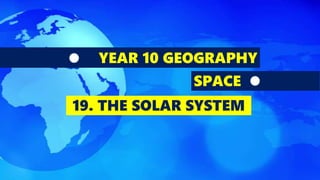
Solar System Bodies and Orbits
- 1. YEAR 10 GEOGRAPHY SPACE 19. THE SOLAR SYSTEM
- 2. The solar system consists of: • a star - the Sun • planets and dwarf planets in orbit around the Sun • satellite moons in orbit around most of the planets • comets and asteroids in orbit around the Sun There are eight planets, including the Earth, and smaller dwarf planets, such as Pluto, Ceres and Eris.
- 3. The solar system (showing from left to right from the Sun): Mercury, Venus, Earth, Mars, Jupiter, Saturn, Uranus and Neptune
- 4. The Sun's gravity keeps the planets, dwarf planets, comets and asteroids in orbit. The gravity of a planet keeps its own satellites in orbit.
- 5. The planets take different amounts of time to go around the Sun. A single orbit is called the planet's year, and the further out a planet is the longer its year takes. The orbits of the planets in the solar system are almost circular – with the Sun near the centre. Many diagrams - including the next slides - show the orbits very squashed from top to bottom. This is to give a sense of perspective or to fit the diagram to a page in a book.
- 6. The orbits of the eight planets
- 7. Comets are balls of ice and dust in orbit around the Sun. The orbits of comets are different from those of planets - they are elliptical. A comet's orbit takes it very close to the Sun and then far away again. The time to complete an orbit varies - some comets take a few years, while others take millions of years to complete an orbit. Comets are often visible from Earth when they get close to the Sun, because the Sun's heat vaporises material from their surface, and this vapour forms a tail which always points away from the Sun.
- 8. Comets have a range of different orbital periods and all leave a trail of debris behind them
- 9. Types of orbit around Earth
- 10. Asteroids are comprised of rock and metal, and are smaller than planets. Most of them are found in an 'asteroid belt', in orbit around the Sun between Mars and Jupiter. The minor planet Ceres is found here, too. Asteroids can crash into each other. When they do, they may break apart and their orbit may change.
- 11. A meteor hurtling towards Earth and burning up as it hits the atmosphere
- 12. The orbits of some asteroids cross the Earth's orbit. At various times during the Earth's history, asteroids have hit the Earth. When this happened, a tremendous amount of energy was released, throwing up billions of tonnes of dust. This huge dust cloud blocked heat and light from the Sun, making the Earth very cold. It is thought that this drop in temperature contributed to the extinction of dinosaurs. Scientists worry that an asteroid could still hit the Earth and cause a global catastrophe.
- 13. A satellite is anything that orbits a celestial body (star, planet, moon etc). Both natural and artificial satellites exist. The Moon is the Earth’s natural satellite. Scientists believe that it was formed when a Mars-sized planet collided with the early Earth, throwing some of the crust into orbit. However the Moon was formed, it is locked into the Earth’s gravitation field and circles our planet once every 27.5 days. Many other moons are the natural satellites for other planets in our solar system and beyond.
- 14. Most of the 178 known natural satellites are irregular moons, while only 19 are large enough to be round. Ganymede, followed by Titan, Callisto, Io and Earth's Moon are the largest natural satellites in the Solar System
- 15. These have been placed into orbit by man. Among other jobs, artificial satellites orbiting the Earth are used for: • telecommunications (transmitting information between distant parts of the Earth) • satellite navigation systems (‘satnav’) • spying on other countries • weather forecasts
- 16. Communications satellites occupy a geostationary orbit. They are in orbit above the equator at just the right distance so that it takes them one day to complete an orbit. As a result, they always appear in the same position when seen from the ground. This is why satellite television dishes can be bolted into position and do not need to move. Earth observation and monitoring satellites occupy polar orbits, passing over the North and South poles, and crossing the equator twice during each orbit. The Earth spins beneath the satellite as it moves, so the satellite can scan the whole surface of the Earth.
- 17. The further a planet is from the sun: • the slower it moves • the more time it takes to complete an orbit For example, Mercury, the closest planet to the Sun, takes just 88 Earth days to complete an orbit. But Neptune, the furthest out, takes 164 Earth years to complete an orbit.
